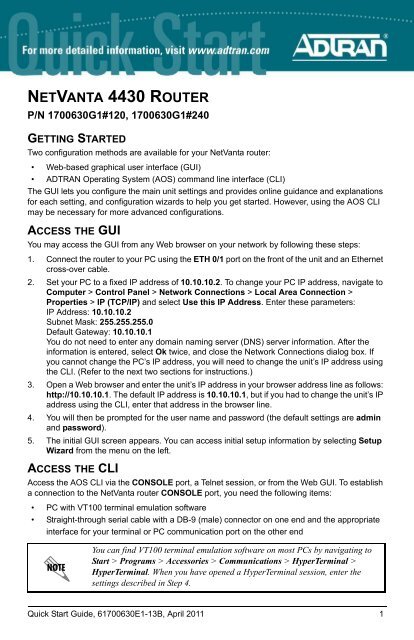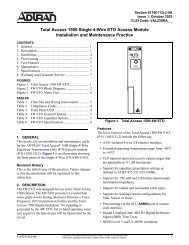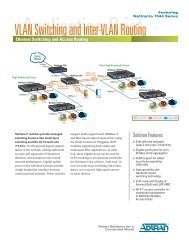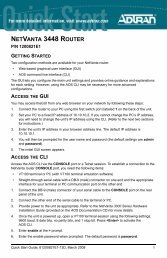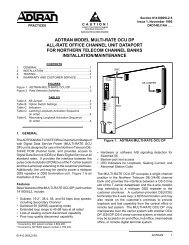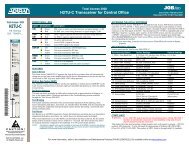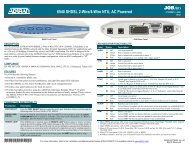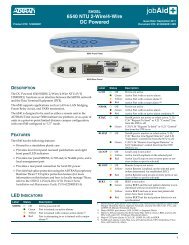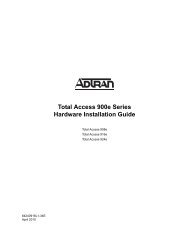NetVanta 4430 Router Quick Start Guide - Adtran
NetVanta 4430 Router Quick Start Guide - Adtran
NetVanta 4430 Router Quick Start Guide - Adtran
You also want an ePaper? Increase the reach of your titles
YUMPU automatically turns print PDFs into web optimized ePapers that Google loves.
NETVANTA <strong>4430</strong> ROUTER<br />
P/N 1700630G1#120, 1700630G1#240<br />
GETTING STARTED<br />
Two configuration methods are available for your <strong>NetVanta</strong> router:<br />
• Web-based graphical user interface (GUI)<br />
• ADTRAN Operating System (AOS) command line interface (CLI)<br />
The GUI lets you configure the main unit settings and provides online guidance and explanations<br />
for each setting, and configuration wizards to help you get started. However, using the AOS CLI<br />
may be necessary for more advanced configurations.<br />
ACCESS THE GUI<br />
You may access the GUI from any Web browser on your network by following these steps:<br />
1. Connect the router to your PC using the ETH 0/1 port on the front of the unit and an Ethernet<br />
cross-over cable.<br />
2. Set your PC to a fixed IP address of 10.10.10.2. To change your PC IP address, navigate to<br />
Computer > Control Panel > Network Connections > Local Area Connection ><br />
Properties > IP (TCP/IP) and select Use this IP Address. Enter these parameters:<br />
IP Address: 10.10.10.2<br />
Subnet Mask: 255.255.255.0<br />
Default Gateway: 10.10.10.1<br />
You do not need to enter any domain naming server (DNS) server information. After the<br />
information is entered, select Ok twice, and close the Network Connections dialog box. If<br />
you cannot change the PC’s IP address, you will need to change the unit’s IP address using<br />
the CLI. (Refer to the next two sections for instructions.)<br />
3. Open a Web browser and enter the unit’s IP address in your browser address line as follows:<br />
http://10.10.10.1. The default IP address is 10.10.10.1, but if you had to change the unit’s IP<br />
address using the CLI, enter that address in the browser line.<br />
4. You will then be prompted for the user name and password (the default settings are admin<br />
and password).<br />
5. The initial GUI screen appears. You can access initial setup information by selecting Setup<br />
Wizard from the menu on the left.<br />
ACCESS THE CLI<br />
Access the AOS CLI via the CONSOLE port, a Telnet session, or from the Web GUI. To establish<br />
a connection to the <strong>NetVanta</strong> router CONSOLE port, you need the following items:<br />
• PC with VT100 terminal emulation software<br />
• Straight-through serial cable with a DB-9 (male) connector on one end and the appropriate<br />
interface for your terminal or PC communication port on the other end<br />
You can find VT100 terminal emulation software on most PCs by navigating to<br />
<strong>Start</strong> > Programs > Accessories > Communications > HyperTerminal ><br />
HyperTerminal. When you have opened a HyperTerminal session, enter the<br />
settings described in Step 4.<br />
<strong>Quick</strong> <strong>Start</strong> <strong>Guide</strong>, 61700630E1-13B, April 2011 1
1. Connect the DB-9 (male) connector of your serial cable to the CONSOLE port on the rear<br />
panel of the unit.<br />
2. Connect the other end of the serial cable to the terminal or PC.<br />
Many PCs do not come with a standard serial port. A universal serial bus (USB)<br />
to serial adapter can be used instead. The drivers for the USB to serial adapter<br />
must be installed according to the manufacturer’s instructions. If the USB to<br />
serial adapter is not properly installed on your PC, you will not be able to<br />
communicate with the AOS unit and you should seek support from the USB to<br />
serial adapter manufacturer.<br />
3. Provide power to the unit as appropriate. Refer to the <strong>NetVanta</strong> 4000 Series Hardware<br />
Installation <strong>Guide</strong> (ADTRAN’s Knowledge Base article 2337) at http://kb.adtran.com for<br />
more details.<br />
4. Once the unit is powered up, open a VT100 terminal session using the following settings:<br />
9600 baud, 8 data bits, no parity bits, 1 stop bit, and no flow control. Press to<br />
activate the AOS CLI.<br />
5. Enter enable at the > prompt and enter the Enable mode password when prompted. The<br />
default password is password.<br />
You can also access the CLI from a Telnet client. In order to do this, you must know the IP<br />
address of the AOS device. If you do not know the unit’s IP address, you must use the CONSOLE<br />
port to access the CLI. To access the CLI using a Telnet client, follow these steps:<br />
1. Connect the AOS device’s ETH 0/1 port to your computer’s Ethernet interface using an<br />
Ethernet cross-over cable.<br />
2. Open a Telnet client on your computer. You can access the Telnet client by navigating to<br />
<strong>Start</strong> > Run and entering telnet 10.10.10.1 (Windows XP). If you are running Windows<br />
Vista, you will need to turn on the Telnet client before you access it. To do this, navigate to<br />
<strong>Start</strong> > Control Panel > Programs and Features > Turn Windows features on or off ><br />
Telnet Client Option and select OK. 10.10.10.1 is the default unit IP address. If you have<br />
changed your unit’s IP address, you will need to enter that address.<br />
3. Enter enable at the > prompt and enter the enable password when prompted. The default<br />
password is password.<br />
COMMON CLI COMMANDS<br />
The following are common CLI commands and tips for getting started with the CLI.<br />
• Entering a question mark (?) shows contextual help and options. For example, entering ? at<br />
the prompt will show all commands available from that prompt.<br />
• To view interface statistics, enter show interface .<br />
• To view the current configuration, enter show running-config.<br />
• To view all the IP addresses currently configured, enter show ip interface brief.<br />
• To view the AOS version, serial number, and other information, enter show version.<br />
• To view the routing table, enter show ip route.<br />
• To save the current configuration, enter write.<br />
2 Copyright © 2011 ADTRAN, Inc. All Rights Reserved.
CONFIGURE THE UNIT’S IP ADDRESS<br />
The configuration parameters used in the examples outlined in this<br />
document are for instructional purposes only. Please replace all<br />
underlined entries (example) with your specific parameters to configure<br />
your application.<br />
The following steps create an IP address (10.10.10.1 255.255.255.0) for Ethernet port 0/1. If you<br />
are not sure what IP address to assign, please contact your network administrator.<br />
1. At the # prompt, enter config terminal.<br />
2. At the (config)# prompt, enter interface eth 0/1 to access the configuration parameters for<br />
the ETH 0/1 port located on the rear of the unit.<br />
3. Enter ip address 10.10.10.1 255.255.255.0 to assign an IP address to the ETH 0/1 port<br />
using a 24-bit subnet mask.<br />
4. Enter no shutdown to activate the interface to pass data.<br />
5. Enter exit to exit the Ethernet interface commands and return to the Global Configuration<br />
mode.<br />
6. Enter ip route 0.0.0.0 0.0.0.0 192.168.1.254 to add a default route to the route table. 0.0.0.0<br />
is the default route and the default subnet mask, and 192.168.1.254 is the next-hop IP<br />
address to which the AOS router should send all of its traffic. You will need to enter the<br />
proper route, subnet mask, and gateway for your network. This information is typically<br />
provided by an Internet service provider (ISP) or local network administrator.<br />
7. Enter do write memory to save the current configuration.<br />
ENABLE TELNET USER LOGIN ACCESS<br />
The following steps enable user login parameters for Telnet access by changing the password<br />
from the default (password) and enabling security login on Telnet lines.<br />
1. Verify that the prompt of your unit displays (config)#.<br />
2. Enter line telnet 0 4 to change the configuration parameters for the Telnet sessions.<br />
3. Enter login to prompt users with a login prompt for Telnet access.<br />
4. Enter password adtran to change the login password for the Telnet sessions.<br />
5. Enter exit to return to the Global Configuration mode.<br />
6. Verify that the prompt of your unit displays (config)#.<br />
7. Enter do write memory to save the current configuration.<br />
<strong>Quick</strong> <strong>Start</strong> <strong>Guide</strong>, 61700630E1-13B, April 2011 3
CONFIGURE YOUR APPLICATION<br />
The applications you will need to configure vary by product and by network. Review the list of<br />
defaults for your unit before deciding what applications to configure. The following are some<br />
common applications that should be configured on startup. These are all available on ADTRAN’s<br />
Knowledge Base.<br />
Configuring T1 Access to a Remote Site<br />
Using PPP in AOS (video article 2003)<br />
Configuring Port Forwarding in AOS<br />
(video article 2291)<br />
RESTORING FACTORY DEFAULTS<br />
Configuring Internet Access (Many to One NAT) with<br />
the Firewall Wizard in AOS (video article 2185)<br />
Configuring QoS for VoIP in AOS<br />
(video article 3091)<br />
Configuring PPP in AOS (article 2523) Configuring HDLC in AOS (article 2152)<br />
Configuring Frame Relay in AOS<br />
(article 2350)<br />
Configuring DHCP Server in AOS<br />
(article 2149)<br />
Configuring a VPN Using Aggressive Mode in<br />
AOS (article 1926)<br />
Configuring QoS in AOS<br />
(article 1617)<br />
Configuring a VPN Using Main Mode in AOS<br />
(article 1925)<br />
Important: For additional details on product features, specifications,<br />
installation, and safety, refer to <strong>NetVanta</strong> 4000 Series Hardware Installation<br />
<strong>Guide</strong> (ADTRAN’s Knowledge Base article 2337) at http://kb.adtran.com.<br />
NETVANTA 4000 SERIES DEFAULTS<br />
Feature Default Value<br />
IP Address 10.10.10.1<br />
Username admin<br />
Password password<br />
HTTP Server Enabled<br />
Event History On<br />
IP Routing Enabled<br />
On units that have a console port, you cannot restore the factory defaults, but must rather erase<br />
the device’s configuration and then reconfigure the unit to operate correctly for your network. To<br />
erase the unit’s current configuration, follow these steps:<br />
1. Access the unit’s CLI and enter enable at the > prompt.<br />
2. Enter erase startup-config at the # prompt. The device will have a blank configuration upon<br />
reboot.<br />
3. Enter reload at the # prompt to begin restarting the device. When prompted to save<br />
configuration, enter no. When prompted to reboot, enter yes.<br />
4. Upon reboot, you will have to reconfigure the unit using the CONSOLE port. Follow the<br />
steps outlined here or in the technical note, Accessing the Web Interface in AOS<br />
(ADTRAN’s Knowledge Base article 1788) at http://kb.adtran.com.<br />
4 Copyright © 2011 ADTRAN, Inc. All Rights Reserved.


